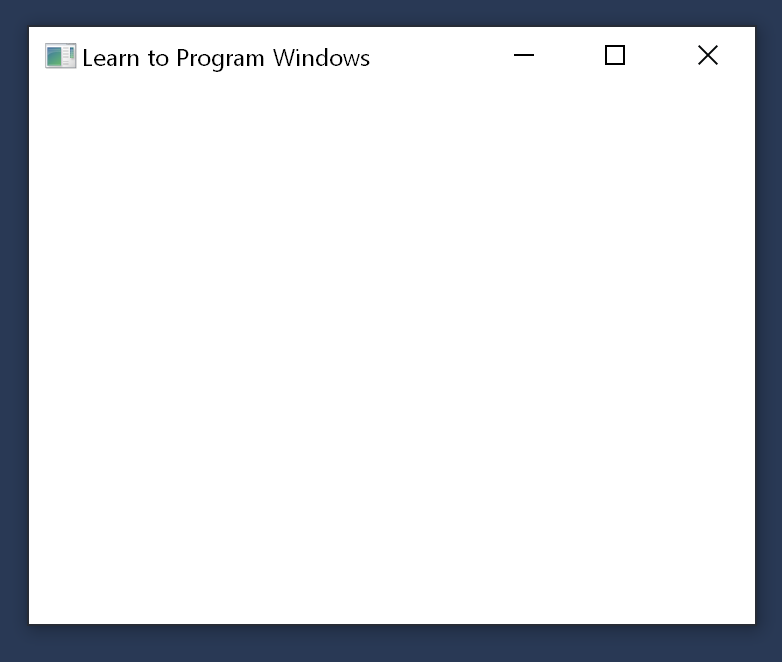模組 1. 您的第一個 Windows 程式
在此課程模組中,我們將撰寫最小的 Windows 桌面程式。 其全部都是建立並顯示空白視窗。 第一個套裝程式含大約 50 行的程式碼,不會計算空白行和批註。 這會是我們起點;稍後我們將新增圖形、文字、使用者輸入和其他功能。
如果您想要深入瞭解如何在 Visual Studio 中建立傳統 Windows 傳統型應用程式,請參閱逐步解說 :建立傳統 Windows 傳統型應用程式 (C++) 。

以下是程式的完整程式碼:
#ifndef UNICODE
#define UNICODE
#endif
#include <windows.h>
LRESULT CALLBACK WindowProc(HWND hwnd, UINT uMsg, WPARAM wParam, LPARAM lParam);
int WINAPI wWinMain(HINSTANCE hInstance, HINSTANCE hPrevInstance, PWSTR pCmdLine, int nCmdShow)
{
// Register the window class.
const wchar_t CLASS_NAME[] = L"Sample Window Class";
WNDCLASS wc = { };
wc.lpfnWndProc = WindowProc;
wc.hInstance = hInstance;
wc.lpszClassName = CLASS_NAME;
RegisterClass(&wc);
// Create the window.
HWND hwnd = CreateWindowEx(
0, // Optional window styles.
CLASS_NAME, // Window class
L"Learn to Program Windows", // Window text
WS_OVERLAPPEDWINDOW, // Window style
// Size and position
CW_USEDEFAULT, CW_USEDEFAULT, CW_USEDEFAULT, CW_USEDEFAULT,
NULL, // Parent window
NULL, // Menu
hInstance, // Instance handle
NULL // Additional application data
);
if (hwnd == NULL)
{
return 0;
}
ShowWindow(hwnd, nCmdShow);
// Run the message loop.
MSG msg = { };
while (GetMessage(&msg, NULL, 0, 0) > 0)
{
TranslateMessage(&msg);
DispatchMessage(&msg);
}
return 0;
}
LRESULT CALLBACK WindowProc(HWND hwnd, UINT uMsg, WPARAM wParam, LPARAM lParam)
{
switch (uMsg)
{
case WM_DESTROY:
PostQuitMessage(0);
return 0;
case WM_PAINT:
{
PAINTSTRUCT ps;
HDC hdc = BeginPaint(hwnd, &ps);
// All painting occurs here, between BeginPaint and EndPaint.
FillRect(hdc, &ps.rcPaint, (HBRUSH) (COLOR_WINDOW+1));
EndPaint(hwnd, &ps);
}
return 0;
}
return DefWindowProc(hwnd, uMsg, wParam, lParam);
}
您可以從Windows Hello World Sample下載完整的 Visual Studio 專案。
提供此程式碼用途的簡短大綱可能很有用。 稍後的主題會詳細檢查程式碼。
- wWinMain 是程式進入點。 當程式啟動時,它會註冊應用程式視窗行為的一些相關資訊。 其中一個最重要的專案是函式的位址,在此範例中命名
WindowProc。 此函式會定義視窗的行為—其外觀、其與使用者互動的方式等等。 - 接下來,程式會建立視窗,並接收可唯一識別視窗的控制碼。
- 如果已成功建立視窗,程式就會進入 while 迴圈。 程式會保留在這個迴圈中,直到使用者關閉視窗並結束應用程式為止。
請注意,即使我們說這是定義大部分應用程式邏輯的地方,程式也不會明確呼叫 WindowProc 函式。 Windows 會透過傳遞一系列 訊息來與您的程式通訊。 while迴圈中的程式碼會驅動此程式。 每次程式呼叫 DispatchMessage 函式時,都會間接讓 Windows 針對每個訊息叫用 WindowProc 函式一次。
本節內容
相關主題
意見反應
即將登場:在 2024 年,我們將逐步淘汰 GitHub 問題作為內容的意見反應機制,並將它取代為新的意見反應系統。 如需詳細資訊,請參閱:https://aka.ms/ContentUserFeedback。
提交並檢視相關的意見反應